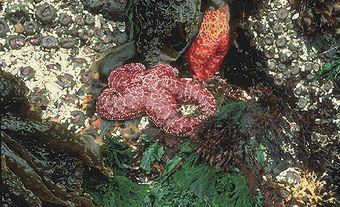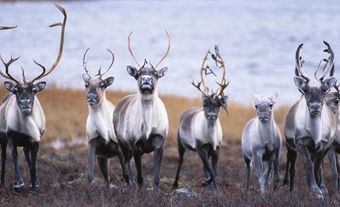Winter is the season that begins December 21 (winter solstice) and ends on March 21 (spring Equinox). In Canada cold and snow is associated with this season. The sun is closest to Earth in January but it is the sun's radiation striking the land at an oblique angle that makes this season generally cold; and the further north the more oblique this angle becomes and the colder it gets. Land takes time to cool down in fall and early winter so the depth of winter does not set in until January and as Canadians know, winter is by no means over on March 21.
When the temperature dips below 0º C fresh water turns from a liquid to a solid and since all life is based on water this becomes a problem for many organisms. Lakes freeze over and rain turns to snow. Snow, however, is a blessing to many small animals including various invertebrates and small mammals. Snow insulates so life at the soil surface beneath the snow in the so-called subnivean space can be favourable. Snow may also protect these animals from predators. However, for the animals above the snow and travelling through it, it adversely affects their movement.
Animals may be endotherms (warm-blooded) maintaining a constant internal temperature or ectotherms (cold-blooded) with their body temperature tending to vary with the external temperature. Some ectotherms are able to produce some heat thermogenically or by using the energy from the sun to heat up (for example, basking), so their body temperatures do not necessarily vary with the external temperature.
Ectotherms
Behavioural and complex biochemical responses to deepening cold and other environmental factors allow ectothermic animals to survive winter in the temperate zones of Canada.
Endotherm Animals
Birds and mammals tend to either escape winter by migrating south (for example many birds and barren-ground caribou, which leave the tundra and enter the Boreal Forest) or endure winter by either being active, entering periods of torpor or hibernating. Heat is lost through conduction (direct transfer), convection (heat carried away by the movement of air), radiation (losing radiant heat) and evaporation (heat loss due to water evaporating). Heat lost due to conduction and convection can be minimized through efficient insulation such as a fat layer and/or body coverings (fur or feathers). The Arctic fox has such a well-insulated coat that it is thermoneutral down to -80º C. In winter birds and mammals often grow more fur and feathers, and these can be fluffed up (piloerection) to increase insulation.
Torpor
Some winter-active mammals (shrews and deer mice), and birds (chickadees), undergo nightly torpor by dropping their body temperatures a few degrees to reduce heat loss. black bears, which accumulate fat to supply energy during winter, are deep sleepers because their temperatures remain nearly normal although respiration and heart rates decrease sharply. They may lose up to 40% of their pre-dormancy weight over winter. Bears, raccoons, skunks and chipmunks awaken on mild, midwinter days to seek food or change dens.
Hibernation
Hibernation, during which metabolism may be only 1-5% of normal, is marked by body temperatures 20° C or more below normal (hypothermia). Respiration and heart rates drop to low levels and become irregular. Woodchucks may breathe 10 times per hour, their hearts slow to 4-5 beats per minute and internal temperatures drop to a few degrees above freezing. Hibernators such as jumping mice, nonmigratory bats and ground squirrels (including woodchucks and marmots) accumulate body fat for insulation and energy to survive long dormant periods. An energy-rich tissue called brown fat is used by hibernants for internal heat production (nonshivering thermogenesis) during frequent periods of arousal.
Other Strategies
Apart from growing more hair (underfur) or feathers (down) during winter, birds and mammals rely on behavioural strategies for staying warm. Mammals curl up, draw their legs in under them and cover their nose with their tail to conserve heat. Some birds and mammals will huddle together to conserve heat.
Physiological reactions of endotherms to chilling include raising or lowering heat production through metabolic processes, producing heat by muscle tremors (shivering thermogenesis), relying on brown fat (non-shivering thermogenesis) and reducing blood flow to the skin (vasoconstriction). White winter coats of ptarmigan, weasels and hare may serve as concealing colouration, but the air within the hollow (white) feathers and hair (caribou, polar bear) also possibly aids insulation. For example, the polar bear has black skin and the white hollow hair brings the suns rays right down to the skin and heats it up. Most birds deposit only enough fat to survive a day or 2 since additional weight poses flight problems. Deer can slow their metabolism during cold periods and so require less food. Birds shiver to maintain body temperatures when not flying, an activity that generates heat from the flight muscles.
Some animals, including wading birds, gulls and caribou, have complex vascular networks in their limbs so that heat moves from warmer arteries to cooler veins for return to deep body tissues. These counter-current heat exchange systems, also present in the tails of beaver, greatly reduce heat losses in winter.
Shrews, voles and mice live in the subnivean space where the temperature is moderate, there is abundant food and they are protected to some degree from predators. Many voles and mice show cyclical population dynamics but these cycles are disappearing likely due to more variable winters due to climate change. Grouse will take advantage of the insulative nature of snow by diving into the snow and making a kind of quinzhee (a shelter made by digging a cavity in a mound of settled snow) where they spend the night protected from the cold.
Getting enough food in winter is often a bigger problem that preventing heat loss. Many animals such as red squirrels, chipmunks, pikas, weasels, chickadees, blue jays and owls store food for consumption later. The boreal owl will store voles but in order to be able to later eat them they sit on the frozen vole to thaw it.
In deep snow, deer and moose gather in areas of softwood shelter and hardwood browse. Deer trample down snow to form a maze of trails between feeding and resting sites (deer yards). In mountains, herds of mule deer and elk seek less severe conditions by moving down south-facing slopes.
Winter is a challenging period for animals and ultimately it is acquiring enough food that is most critical for survival. With climate change, surviving winter may become an even greater challenge for many animals while benefitting a few.
Insects and Other Invertebrates
A period of arrested growth and development (diapause) characterizes the life cycle of most insects that winter in egg, larval, pupal or, uncommonly, adult stages. Generally, overwintering insects are either freeze-susceptible (freeze-intolerant) and cannot survive ice formation in their tissues, or they are freeze-tolerant.
Freeze-susceptible insects avoid freezing by supercooling. They empty the gut, reduce body water content, produce antifreeze (cryoprotectant) substances, for example glycerol, through anaerobic pathways and seek dry sites for the winter.
Freeze-tolerant insects encourage ice formation with ice-nucleating proteins a few degrees below 0° C but restrict ice to extracellular spaces and limit total ice formation with antifreeze compounds. They may survive temperatures to -50° C or lower. No animal is known to survive complete freezing of tissue water because intracellular ice (ice crystal formation within cells) damages the cell wall and organelles.
Aquatic species overwintering as adults often move to terrestrial sites or from shallow ponds to larger streams and deep pools while others overwinter as eggs above or near water. Chironomid (nonbiting midges) larvae construct firm winter cocoons and caddisflies seal the summer case for winter. Stoneflies, caddisflies and mayflies, although believed to be freeze-tolerant, avoid freezing temperatures. Some marine intertidal animals such as molluscs are also freeze-tolerant.
Terrestrial species wintering in plants and tree bark enter deep crevices or fissures. Moths, butterflies and other insects overwinter in special cocoons or hibernacula which may resist ice inoculation and desiccation. Many beetles, flies, wasps, moths and butterflies are freeze-tolerant. Others winter in the subnivean space.A snow pack of even 10 cm stabilizes soil surface temperatures depending on the air temperature, and at -50º C a snow pack of half a metre can give a subnivean temperature of up to -5º C. Snow also maintains humidity, protecting insects from drying out.
Insects active above the snow, including snow fleas, moths and scorpionflies, raise body temperatures by basking in the sun. Most winter-active terrestrial insects, mainly adults but also larvae, live in the subnivean space together with spiders, mites and ticks.
Lower Vertebrates
Freshwater fish, either semidormant (eels) or active through an elevated metabolism, are protected under the ice by their body fluids, which freeze at a lower temperature than fresh water. Marine fish migrate to deeper water or, like cod, sculpin and flounder, produce antifreeze compounds (peptides or glycopeptides) for resistance to freezing in ice-laden shallow salt water.
Amphibians and reptiles survive winter lying dormant under decaying logs, in rock crevices, caves or burrows of other animals. Many amphibians shelter in streambanks or near springs, or burrow in mud of swamps, ponds and lake bottoms where turtles and salamanders also overwinter. Like many ectotherms, red-spotted newts can adjust metabolism over time to become acclimatized to cold and remain active in water. Blue-spotted salamanders, likely freeze-tolerant animals, may migrate over snow and ice in temperatures of 1° to 3° C.
Stream and lake-bottom hibernators such as green and leopard frogs, although torpid in water temperatures of 0.5° to 2° C, are capable of swimming. Bullfrogs survive in deep ponds where adequate oxygen is available. Toads burrow down into the soil to overwinter. A few amphibians and reptiles remain above ground in winter, protected only by moss, ground litter and snow.
Freeze-tolerant species such as wood frogs and spring peepers convert liver glycogen to glucose, which acts as an antifreeze to prevent cells from freezing but allows extracellular ice. With an ice content of 60-65%, the heart stops, breathing ceases and the frog survives through anaerobic metabolism. If temperatures drop below -7º C, these frogs will die; thus snow cover is important for their survival.
Snakes, sometimes in mixed species groups, gather in rock dens. Garter snakes, which are freeze-tolerant, may travel several kilometres to overwinter in the same site each year. With climate change Canadian winters have become variable with periods of thawing and freezing during winter. Many invertebrates, amphibians and snakes may become vulnerable and even die if they begin to move around during warm spells but then get caught by a freezing spell.

 Share on Facebook
Share on Facebook Share on X
Share on X Share by Email
Share by Email Share on Google Classroom
Share on Google Classroom






